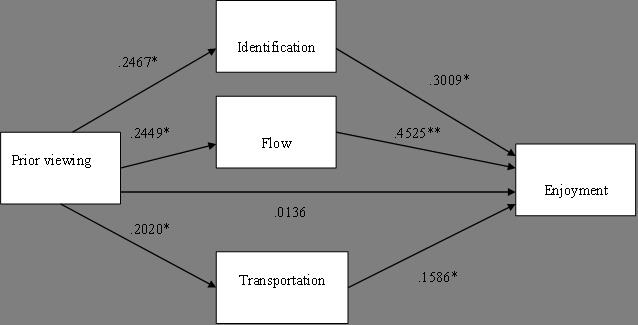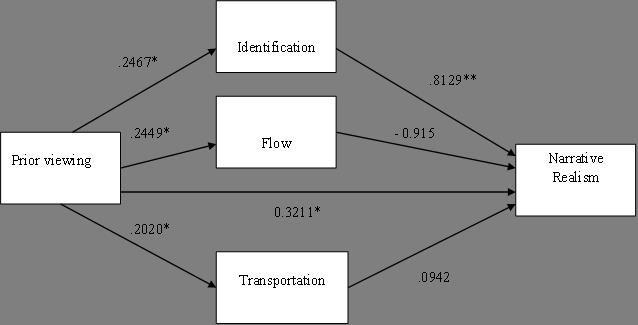Media Effects Research Lab - Research Archive
Does familiarity breed enjoyment?
Student Researcher(s)
Arienne Ferchaud (Masters Candidate);
Tsai-Wei Chen (Masters Candidate);
Neelam Dwivedi (Masters Candidate);
Faculty Supervisor
INTRODUCTION
This research examines the influence of contextual and language familiarity on viewer's experience of enjoyment and narrative realism in science fiction movies. Our research was guided by the theoretical model of narrative comprehension and engagement proposed by Busselle and Bilandzic (2008) (See Figure 1). The phenomenon of fictional language use in sci-fi movies was studied in an experiment where 147 participants were shown a fictional movie clip with an alien character speaking one of three languages with varying levels of familiarity. While contextual familiarity through prior viewing was found to significantly influence enjoyment and narrative realism, the effect of language familiarity was not significant.

Figure 1: Adaptation of Busselle & Bilandzic (2008) model of narrative comprehension and engagement
RESEARCH QUESTION / HYPOTHESES:
RQ1: For the general population, controlling for age, gender, and ethnicity, what is the relationship between viewer's contextual familiarity with the narrative and viewer's enjoyment?
RQ2: For the general population, controlling for age, gender, and ethnicity, what is the relationship between viewer's language familiarity and viewer's enjoyment?
RQ3: For the general population, controlling for age, gender, and ethnicity, what is relationship between viewer's contextual familiarity with the narrative and viewer's perceived narrative realism?
RQ4: For the general population, controlling for age, gender, and ethnicity, what is the relationship between viewer's language familiarity and viewer's perceived narrative realism?
H1a: The relationship between contextual familiarity and enjoyment will be mediated by viewer's flow experience. .
H1b: The relationship between contextual familiarity and perceived narrative realism will be mediated by viewer's flow experience..
H1c: The relationship between language familiarity and enjoyment will be mediated by viewer's flow experience.
H1d: The relationship between language familiarity and perceived narrative realism will be mediated by viewer's flow experience
H2a: The relationship between contextual familiarity and enjoyment will be mediated by the viewer's experience of transportation.
H2b: The relationship between contextual familiarity and perceived narrative realism will be mediated by the viewer's experience of transportation.
H2c: The relationship between language familiarity and enjoyment will be mediated by the viewer's experience of transportation.
H2d: The relationship between language familiarity and perceived narrative realism will be mediated by the viewer's experience of transportation.
H3a: The relationship between contextual familiarity and enjoyment will be mediated by viewer's experience of identification.
H3b: The relationship between contextual familiarity and perceived narrative realism will be mediated by viewer's experience of identification.
H3c: The relationship between language familiarity and enjoyment will be mediated by viewer's experience of identification.
H3d: The relationship between language familiarity and perceived narrative realism will be mediated by viewer's experience of identification.
METHOD
To test our hypotheses, we utilized a 2 x 3 between-subjects factorial design. Contextual familiarity was operationalized as whether or not participants had seen the film prior to watching the clip, while language familiarity was operationalized as the language of the clip being English, Hungarian, or Divine. Participants were recruited from Amazon Mechanical Turk (N=147). All participants resided in the United States in order to minimize possible cultural differences. Each participant was required to watch the video clip in its entirety and then was asked to answer a questionnaire designed to assess prior viewing, language familiarity, identification, transportation, flow, and enjoyment, as well as demographic information.
RESULTS
The results show that higher degree of contextual familiarity is related to higher degree of enjoyment—a relationship that is mediated by the degree of identification, flow, and enjoyment. (See Figure 2 & 3) However, this study did not find a statistically significant relationship between language familiarity and enjoyment. Neither did the study find any significant effect of language familiarity on narrative realism. Finally, analysis showed that prior viewing has a significant impact on narrative realism and identification mediates the relationship between the two.

Figure 2: Parallel mediation model for the relationship between prior viewing and enjoyment

Figure 3: Parallel mediation model for the relationship between prior viewing and narrative realism
CONCLUSIONS
This study examined the relationship between the effect of contextual familiarity and language familiarity on enjoyment and perceived realism. Our findings contribute to current research in three important ways. First, our research provides empirical evidence and points toward potential amendment for the model proposed by Busselle and Bilandzic (2008). Second, while we expected that English, Hungarian, and the fictional Divine language could form a continuum of language familiarity, the manipulation check revealed that the non-English conditions were not distinct from each other, thus making the benefit of using fictional language in sci-fi movies open to question. Finally, the study provides practical implications to those seeking profits in audience enjoyment.
For more details regarding the study contact
Dr. S. Shyam Sundar by e-mail at sss12@psu.edu or by telephone at (814) 865-2173

